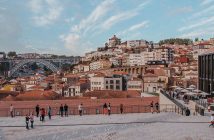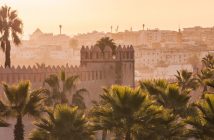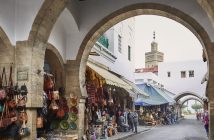Over the next few weeks we’ll be exploring another season of features in the Arb, and the focus of our attention this time is South Africa’s Cape region. There’ll be safaris and sea-faring, fine dining and ‘feinbos’, but first we land with Larry as he explores the natural marvels of Cape Town itself…
I’ve experienced many lunches in dramatic and unusual settings but there’s one place that outdoes them all – picnicking at the foot of Table Mountain. One might argue that anywhere in Cape Town means dining within site of that majestic monument, but what’s rare about this is that we are in the National Park itself, surrounded by scrub bush, sipping champagne and nibbling on springbok canapés with a view out to the endless southern Atlantic.
We are undisturbed, able to appreciate the rarity of the occasion, save the breeze taking our napkins off into the air. We haven’t solicited ourselves here under felonious means, I should add, more that this small, privately-owned enclave happens to be in the grounds of the Twelve Apostles hotel.
So named for the peaks rising behind us, its setting is a feat achieved from its original building as a colonial villa in the 19th c. Fully restored and operated as a hotel from 1996, it still resembles a planter’s house, with white-washed walls and surrounded by lush greens and colourful springtime flora when we arrive. First spotted from the heights above Camps’ Bay, it concludes a drive that serves as a primary introduction to this most iconic of places.

The drive from an airport rarely offers such an overview of a city. Shanty townships are noticeable, unashamedly, straight out of the airport. There is a government initiative to build housing, and I spot evidence of this, but TV seems more of a priority than bricks and mortar judging by the satellite dishes. Significantly, the signature emblem of Cape Town is front and centre for the length of the freeway and virtually unmissable from anywhere in the city: Table Mountain. We arrive with cloud cover, sheet-like and draping over the top; ‘it has its table cloth on’ our driver tells us.
Rounding the mountain, the harbour opens up, the high rises of downtown in evidence from our vantage point. Robben Island sits serenely in the distant haze, presently innocuous but holding my gaze, thoughts of its history never far from one’s imagination.
As we descend into downtown, Table Mountain looms large on our left, and we pass through the picturesque ‘The Gardens’. Round the Lion’s Head through the Glen, Camps Bay opens up before us and Table Mountain’s sheer, soaring eastern peaks, the Twelve Apostles, taper to the sea. And there, in the distance, nestled into verdant hillsides, the distinctive white building of our destination, our eponymous hotel.
The primacy of its location is not lost on those seeking romance; so much so a ‘wedding garden’, with a fixed gazebo, has become a permanent fixture to cater for the 107 ceremonies last year alone, for couples seeking that timeless backdrop. As I tuck into another tuna and avocado blini over lunch, I mutter the immortal words ’I can’t believe I’m here’ a little too audibly over my breath and I’m told that’s precisely why it also serves as a place for proposals.

The nuptial idylls aside, inside it has the feel, too, of its history; the glass lift shaft shows its original workings, the Leopard Bar feels like stepping back in time (although the ceiling fans are electric these days) and whose balcony makes it ‘the last 5* hotel in South Africa,’ I’m told. That is to say, it’s the last luxurious point at which to watch the sun set into the sea (something that attracts visitors in droves).
Rooms are tastefully rendered in whites and blues, with drape-lined four posters and plantation shutters on windows that either overlook the enviable sea views (fully booked during my stay) or the delights of the gardens. Which, too, are also integrated into the swimming pool, forming a water feature backdrop to its lighter dining venue, the Pool Cafe.
It is billed as a ‘Hotel and Spa’ and the latter deserves a mention. An understated entrance suggests nothing of what lies in store; a small reception area descends into a grotto hewn from the rock below the hotel with an assortment of plunge pools and steam rooms, including a saltwater floatation pool.

But the best bits are reserved for those aspects you can’t get anywhere else; a stroll through the garden, into the grounds of the national park, reveals the ruins of a cowshed, now the perfect vantage point for stargazing, and a ‘whale bell’, rung when staff spot movement out to sea during migration season, giving the Leopard Bar terrace its second vantage point. Of all the locations of the world, the 12 Apostles has to be one of the most enviable.
But no view to the mountain prepares you for actually ascending it. The cable car that operates to the top is quick, steep and busy. Thirty plus people cram to a car and the floor rotates to allow a panoramic view, and adding further to the disorientation of scaling the height at speed. It’s a challenging enough ascent by mechanical means but it gives glimpses of those mad enough to attempt it on foot, too. Curiously, wandering the tabletop, so to speak, with its lumpy igneous surface and thin wisps of mist, blown in with a chill breeze, it feels more like Bodmin Moor, but it’s the views one comes up here for. They are, as you’d expect, quite spectacular.
Were it just about this iconic monument, that might be reason enough to visit, but Cape Town’s is a rich, bubbling cauldron of history; a history of struggle, of clashing cultures and class barriers, of suppression and liberation. From its 15th century Portuguese founders to its Dutch settlers to British imperialists, its position as a supply point and stopover to the Indies brought with it a rich cultural diversity and one which, ultimately, led to that word synonymous with 20th century South Africa: apartheid.
A guided tour – and, I should add, one should be guided – doesn’t reveal any great majesty of infrastructure; there are no grand administrative buildings (save the Victorian city hall), no beautiful architectural marvels, but the fabric of the city, from the parking lot where Nelson Mandela gave his first speech of freedom to the colourful houses of Bo-Kaap (a former township on the fringes of the city centre and now, typically, emerging as a trendy, gentrified quarter) oozes narrative. To explore it you feel as if you’re participating in the emergence of a new metropolis, a new cultural melting pot, of ideas and aspiration and innovation; think Shoreditch but city-wide. It’s not fluid, and it’s not all positive, but it has direction and that gives it a frisson of excitement I’ve seldom encountered anywhere else.

That ‘melting pot’ idiom is not hackneyed, incidentally, but does rather offer an analogy for its food scene. Cape Town’s is thriving, and nowhere more so than at Pot Luck Club. Set atop the Old Biscuit Mill in a gentrifying but still rough-round-the-edges area called Woodstock, its outlook onto corrugated rooftops, rusted rail tracks and distant wharf cranes makes Brooklyn look like a Laura Ashley showroom. Pot Luck is the sprightlier, more informal sister to Luke Dale-Roberts’ award-winning Test Kitchen and serves tapas-style dishes from a menu based on the asian flavour system of salt, sour, sweet, bitter and umami. The dishes may be criminally small, virtually a mouthful apiece, but it does give you a chance to try everything on the menu. In spite of which, I had the yellowfin tacos three times over.
Away from the hum of the city, and embracing its maritime heritage, the Cape Grace occupies a plum position on Cape Town’s waterfront set, as it is, within the V&A Marina. Here, I throw open the floor-to-ceiling windows in my room and am met with pristine white yachts lashed to gantries and the setting sun illuminating Signal Hill. If ever there was an image to set the scene for aspirational, contemporary Cape Town, this was it.

There’s a certain nautical theme that continues inside the Grace, too, from the steps that descend into the Bascule bar to the flotsam that’s found its way into the chandeliers in the Signal restaurant and lounge. These are typical of the hotel; over 300 antiques grace the hotel’s communal spaces, and nearly all salvaged from the region. Together with the hand-painted murals depicting key historic scenes, one can spend a pleasant afternoon wandering and peering and exploring, all helping give one a sense of place.
That sense of place is given a sensory twist in the Signal restaurant, offering contemporary food “with a Cape twist”. A twist that is reflective of Cape Malay cuisine, harking back to its history as a stopover point on trade routes. The tasting menu was an easy choice here, presided over as it was by Malvin, the sommelier, whose choice of wines informed the kitchen. The influences were Citrus-cured salmon, goat’s cheese arancini, braised duck with a pear and ginger jus all window-dressed by Rall, Bizoe and Migliarina, three stirling South African producers. It was a meal fitting our departure and indicative of what might be on offer in the days to come as were to embark on the delights of the ‘Garden Route’ the next morning.
As I set foot from the car on arrival at the Cape Grace, I was greeted with a ‘Welcome home, sir’, and it set the precedent for the stay. Now, as I left, I could think of few other places I’d rather call home.
The Twelve Apostles and Cape Grace are part of the Leading Hotels of the World collection. For more information, including details of LHW properties in Africa, offers, inspiration and their Leaders’ Club, visit www.lhw.com.
For further details of the 12 Apostles Hotel, the Cape Grace and lunching at the Pot Luck Club, follow the links to their websites.
Next week, Larry continues his journey across the Cape, along the ‘garden route’, to a golfing mecca – not that he can play – and a private safari…




